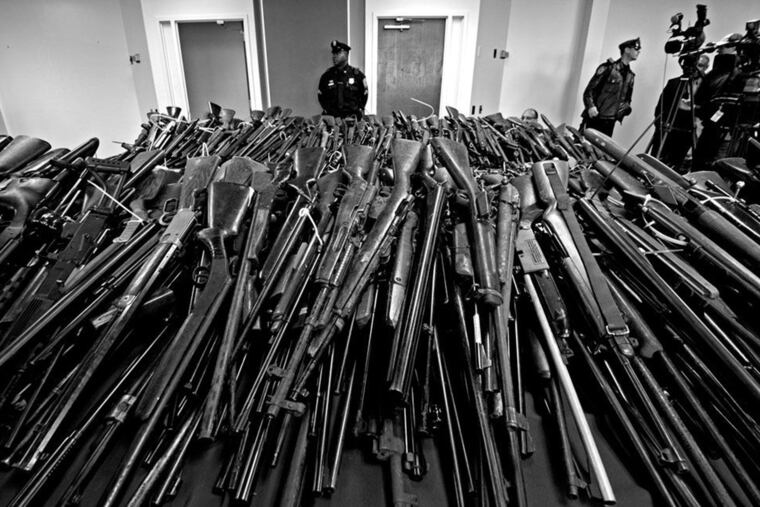Gun buybacks don’t cut crime. Here is what might.
The guns we get back aren't the ones used in crimes. Other cities have boosted rewards for tips and tried other measures that likely work better to reduce crime.

Philadelphia City Council continues to claim gun buybacks should be part of a broad array of violence reduction strategies. Supporters — including some Philadelphia police officers — contend that surrendered weapons could otherwise become guns used in future crimes, or could fall into the hands of children, potentially leading to self-inflicted harm or harm to others.
But here’s the problem: Research shows that gun buybacks — during which people can turn in their weapons in exchange for money — don’t reduce crime.
Recently, we published an evaluation of Philadelphia’s gun buyback program in the journal Injury Prevention. Even though the data haven’t shown that gun buyback programs improve public safety, we hoped we might at least find a localized effect — meaning, that buybacks might reduce crime in certain neighborhoods. Alas, our study didn’t show any neighborhood impact.
Over 34 buyback events from 2019-2021, Philadelphia recovered just over 1,000 firearms for a little less than $100,000. This doesn’t include costs for administration, police staff, and gun disposal, but the program is at least not a drain on city resources. It still is, however, a distraction from other potentially effective approaches to reducing the number of shootings.
Part of the problem is that we do not recover the right guns. There are nearly 400 million guns in America — more guns than people. Most of these will not become guns used in a crime. Crime guns are usually identified by ballistics evidence from the National Integrated Ballistic Information Network. This network contains nearly 6 million records that generate leads connecting bullets fired, crime guns, and the people who fire them.
Tellingly, Philadelphia’s Office of Forensic Science has never found a National Integrated Ballistic Information Network link to a crime with any gun surrendered in the city’s gun buyback program. Clearly, buyback firearms are not the ones causing such misery in the city.
We do not recover the right guns.
How could we be more effective?
In the 1990s, St. Louis experimented with an innovative consent-to-search program. Police officers went door-to-door in high gun-crime areas, and asked parents of young people who were at risk of involvement in gun violence for their permission to search the house for guns. If the officers found illegal weapons, they confiscated them, but neither the occupants nor the children were prosecuted.
In this low-key approach, officers conducted between five and 30 searches per night and found guns half of the time. They recovered an average of three guns per household, bringing in more than 500 guns over 18 months. Impressively, parents gave consent 98% of the time. Because the program was focused on juvenile gun-carrying, and recovered weapons in half the searches conducted, evaluators argued it was a successful way to keep guns out of the hands of young people.
Another option is to increase rewards for crime tips, but only for information leading to specific types of higher-risk weapons. For instance, in collaboration with the Bureau of Alcohol, Tobacco, Firearms and Explosives, police in Washington now offer up to $5,000 for tips leading to an arrest and the recovery of specific weapons. They target firearms modified to fire as fully automatic and ghost guns, weapons that are constructed from parts that do not have a serial number and are untraceable. (In contrast, Philadelphia offers only $500 to anyone who has tips about someone who has or carries an illegal firearm.) Washington’s effort is too recent to evaluate, but it is an innovative attempt to recover guns that carry greater risk to public safety.
» READ MORE: Should Philadelphia continue gun buybacks? | Pro/Con
People in Philadelphia willing to show an ID have always been able to surrender unwanted guns at police stations or to call 911 to surrender them. But our study adds to the decades of evidence that gun buybacks — as we currently operate them — do not make a meaningful contribution to reducing gun crime.
This does not mean we cannot test other ways to get some of the most harmful guns out of public hands and reduce the scourge of gun crime that continues to plague Philadelphia. By electing Cherelle Parker — a candidate who promised a more robust approach to crime — as the city’s next mayor, Philadelphians have signaled gun crime is a priority.
If done right, innovative approaches to reduce gun violence ― such as St. Louis’ consent-to-search program, or increasing rewards for crime tips — also might rebuild some trust between the police department and the community.
Jerry H. Ratcliffe is a professor in Temple University’s Department of Criminal Justice. Marc Huffer is a graduate student in Temple’s Department of Criminal Justice.